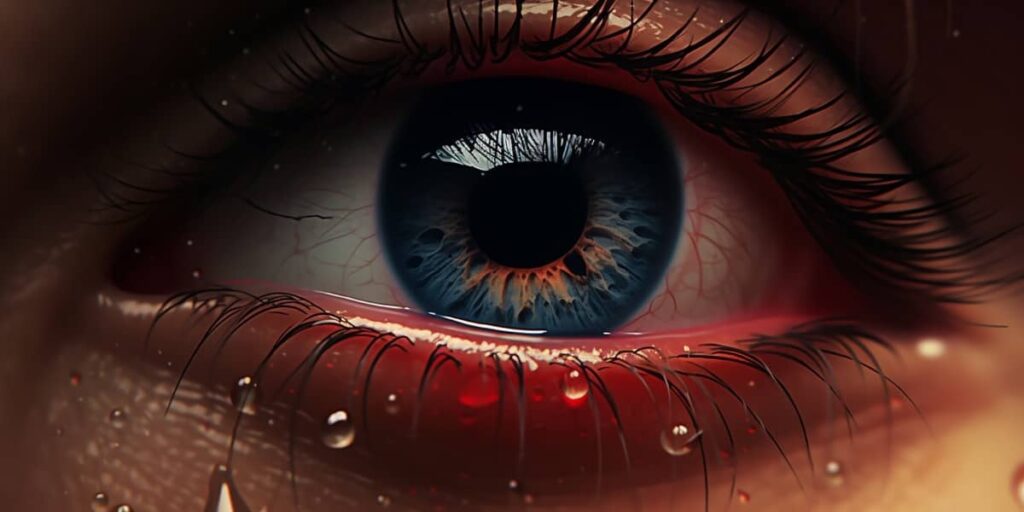Ever found yourself in a heated argument and, before you know it, your eyes well up with tears? If so, believe me, you’re not alone. Crying when mad is more common than you’d think. It’s a natural human reaction that can be quite perplexing. So why do we cry when we get angry? That’s what I’m here to help unravel.
Our bodies have unique ways of dealing with intense emotions and sometimes these responses might seem counterintuitive. Crying during anger is one such response. This can happen due to various reasons including a biological stress response or a psychological need for empathy.
So the next time you find yourself tearing up in the middle of an argument, don’t feel embarrassed or frustrated. It’s just your body trying to cope with overwhelming emotions in the best way it knows how — by crying them out.
Understanding Emotions: Why We Cry When Angry
Let’s talk about a conundrum many of us face. You know that feeling, right? When you’re so mad, you could spit nails… but instead, tears start rolling down your cheeks. It’s baffling! You’re not sad, you’re downright furious! So why on earth are we crying?
Well, it starts with how our brains process emotions. Anger and sadness are closely linked in the brain’s limbic system which governs our emotional responses. When we get mad, these neural pathways light up and sometimes cross wires leading to tears.
Think about it like an electrical circuit. If the energy surge is too strong – say from intense anger – it can spill over into other circuits. It’s like your emotions are trying to balance themselves out – a safety mechanism if you will.
Here are some insights from experts:
- Emotional Overflow: According to Dr. Ad Vingerhoets from Tilburg University in the Netherlands, people often cry when they’re angry due to an overflow of intense emotion.
- Stress Relief: Psychotherapist Tina Gilbertson says that crying might be a way for us to release pent-up stress related to anger.
- Communication Tool: Some psychologists theorize that crying could serve as a non-verbal signal indicating we’ve reached our emotional limit.
There’s really no one-size-fits-all answer as everyone processes their emotions differently. But next time you find yourself tearing up during a heated moment, remember this isn’t weakness or irrationality—it’s just your brain doing its best to handle an overload of emotion. And perhaps understanding this might help us navigate those stormy seas of anger just a little bit better.
Unpacking Emotional Responses: Tears and Anger
Ever wondered why tears sneak up on you when you’re mad? I did too, and it turns out, it’s all related to our complex emotional responses.
Understanding emotions is no simple task; they’re multifaceted and often interconnected. When I’m boiling with anger, for instance, my body might respond in ways that seem contradictory – like crying. But it’s not as paradoxical as it may seem at first glance.
Psychologists explain that crying during anger could be connected to feelings of powerlessness or frustration. You see, when we can’t express our anger or when the situation goes beyond our control, we might cry. It’s a way for the body to cope with overwhelming negative emotions.
Now let’s delve into some numbers here:
| Emotion | Percentage of People who Cry |
|---|---|
| Anger | 46% |
| Sadness | 89% |
| Table: Frequency of Crying during Different Emotions |
As per a study published in the journal “Motivation and Emotion,” roughly 46% of respondents reported crying when angry. This indicates that tears aren’t just associated with sadness – they’re a broader signal of intense emotion.
Consider this scenario – you’re in an argument but feel unheard or misunderstood. That frustrating experience could lead to feelings of helplessness, triggering your tear ducts into action!
So next time you find yourself shedding tears while raging inside don’t beat yourself up over it! It’s perfectly normal – a testament to human complexity if anything.
The Science Behind Crying Out of Frustration or Anger
Ever wondered why tears stream down your face when you’re really mad? It’s not just about feeling sad. There’s a fascinating science behind it.
Our bodies have an intricate system of responses to emotions. When we get angry or frustrated, our brain sets off a series of reactions. One part, the hypothalamus, springs into action and triggers the production of stress hormones like adrenaline. This hormone rush can lead to physical symptoms such as increased heart rate, sweating, and yes – crying.
But why crying? Well, it seems that emotional tears (the ones shed out of anger or frustration) are different from reflexive tears (those caused by onion chopping sessions). Emotional tears contain more proteins and hormones which our body wants to get rid of during stressful times. It’s sorta like nature’s way of calming us down.
Interestingly enough:
- Women reportedly cry more often than men due to hormonal differences.
- People who tend to suppress their anger might be more likely to cry when they finally let it out.
- High levels of emotional intelligence may increase the likelihood of crying during intense feelings.
So next time you find yourself shedding a few tears because things didn’t go as planned or someone pushed your buttons too hard – remember it’s all in the science! Your body is doing what it knows best: trying to help you cope with those tough moments in life.
The Role of Stress in Triggering Emotional Tears
When I’m under a lot of stress, it’s not unusual for me to shed tears. It’s one way my body reacts to the overwhelming feelings that come with stress. So why does this happen?
Well, it turns out there’s some science behind it. When we’re stressed, our bodies produce a hormone called cortisol. This is often referred to as the “stress hormone” because its levels increase when we’re dealing with stressful situations.
Let me give you an example. Have you ever been so frustrated or annoyed that you just felt like crying? That’s probably your body reacting to elevated cortisol levels. Cortisol triggers our fight-or-flight response – a physiological reaction that occurs in response to a perceived harmful event or threat to survival.
But how exactly do these hormones trigger tear production? Here are some key points:
- Cortisol and adrenaline – These two hormones are released during stressful situations and can cause emotional instability, leading us to cry.
- Prolactin – This hormone plays a significant role too since its levels also rise during stress and can stimulate tears.
- Autonomic Nervous System (ANS) – Our ANS controls many functions in our body including tear production. When we’re stressed, our ANS can go into overdrive which could lead us down the path towards those waterworks.
So while it might be frustrating when tears start flowing right at the moment when I’m trying my hardest not to cry, understanding what’s happening inside my body helps put things into perspective!
How Social Conditioning Influences Our Tearful Reactions
Let’s dive right in. Tears, often seen as a sign of emotional vulnerability, are influenced by more than just our immediate feelings. They’re also shaped by societal norms and expectations – something known as social conditioning.
Believe it or not, from an early age we’re taught how to react to certain situations. For instance, boys are frequently told not to cry because it’s “unmanly”. Conversely, girls are generally allowed a wider range of emotional expression including tears. This gendered approach can carry into adulthood and affect the way we respond when we’re upset or angry.
Now you might be thinking, “But I’m an adult! I control my own reactions!” That’s true to an extent. However, years of learned behaviors don’t disappear overnight. If you’ve been conditioned to equate crying with weakness or instability – especially during moments of conflict – then chances are your tear ducts will get busy when the heat is on.
Moreover, societal expectations aren’t limited to gender roles alone. Cultural background plays a significant role too. In some societies crying is largely viewed as cathartic and healing; in others it may be regarded as overly dramatic or inappropriate.
Take Japan for example:
| Country | Attitude towards Crying |
|---|---|
| Japan | Discouraged |
In Japanese society, crying in public is generally frowned upon due to their cultural emphasis on stoicism and restraint.
So if you find yourself tearing up every time you get mad, take heart! It’s not necessarily a sign that something’s wrong with you; instead it could simply be a reflection of social conditioning at play.
Psychological Insights: The Connection Between Anger and Crying
Let’s dive right into the heart of it. Ever wondered why tears well up in your eyes when you’re really angry? Well, it’s not as odd as you may think. In fact, there are numerous psychological reasons that can explain this reaction.
Firstly, crying is a natural response to a wide range of emotions, not just sadness. When we get mad, our bodies often respond by releasing stress hormones like adrenaline and cortisol. These hormones stimulate tears as part of the body’s fight-or-flight response mechanism. It’s an automatic way for the body to signal distress or a need for help.
Secondly, crying can be a form of self-soothing during intense emotional situations such as anger. It helps us regain control over our feelings by reducing tension and calming the nervous system down.
Additionally, consider societal expectations about expressing anger. For many people, showing anger openly is considered inappropriate or unacceptable. Therefore, when we suppress our anger, it might manifest itself in other ways like crying.
Finally, research suggests that tears contain chemicals that can improve mood and relieve stress – possibly another reason why we cry when we’re mad! It appears that Mother Nature equipped us with tear ducts not only to keep our eyes lubricated but also to help us cope better with strong emotions!
So next time you find yourself tearing up during a heated argument or frustrating situation, don’t feel embarrassed or confused – it’s likely just your body doing its best to handle those strong feelings!
Coping Strategies for Managing Emotional Outbursts
Feelings of anger can sometimes be overwhelming, leading to tears. It’s a common reaction and there are several strategies to help manage these emotional outbursts. Let’s delve into some coping mechanisms that might make a difference.
The first step is recognizing your emotions. When you feel the heat of anger rising, it’s crucial to acknowledge it instead of trying to suppress it. Acknowledging your feelings is the initial step towards managing them effectively.
Next comes deep breathing exercises. It might sound cliché but trust me, it works! Deep breathing helps slow down your heart rate and relaxes your body, reducing the intensity of your anger. Here’s how you do it: take a long, slow breath in through your nose; hold it for a moment; then breathe out slowly through your mouth. Repeat this until you start feeling calmer.
Physical activity can also work wonders when you’re mad and on the verge of crying. A brisk walk around the block or even some light stretching can release pent-up energy, helping you regain composure.
You might also want to try distraction techniques like listening to calming music or focusing on something visually soothing (like pictures or videos of nature). This technique helps shift attention away from what’s causing distress.
Lastly, don’t underestimate the power of talking it out with someone trusted—a friend, family member or therapist can provide much-needed perspective and advice during these challenging moments.
So here are some effective strategies:
- Recognizing emotions
- Deep breathing exercises
- Physical activities
- Distraction techniques
- Talking things over
Remember: Everyone has unique ways they react when they get mad—some cry while others yell or become silent—it doesn’t make anyone less capable or strong.
Conclusion: Acceptance and Control Over Emotional Reactions
I’ve spent quite some time delving into why we cry when we get mad. It’s a fascinating exploration of our emotional intricacies. Yet, the journey doesn’t stop at understanding. True progress lies in acceptance and control.
Accepting that crying is a normal reaction to anger starts us off on the path towards emotional mastery. It’s crucial not to see these tears as weakness, but rather as an inherent part of our human experience. Recognizing this fact can be empowering and helps take away any shame associated with it.
Next comes control. I’m not advocating for suppressing your emotions, far from it! Instead, I suggest learning techniques that can help manage them better:
- Breathing exercises like deep breathing or 4-7-8 breathing
- Mindfulness meditation
- Cognitive Behavioral Therapy (CBT)
- Regular physical exercise
These methods have shown promise in helping individuals gain more control over their emotional reactions.
Remember, no one is perfect; we all have moments when our emotions get the best of us. What matters most is how we learn from these experiences and strive for growth.
In conclusion, understanding why you cry when angry is just the beginning – accepting and controlling your emotional responses are where real change begins! So next time you find yourself tearing up out of frustration or rage, remember: it’s okay to feel this way, but there are ways to navigate through it more comfortably.



